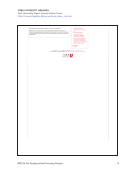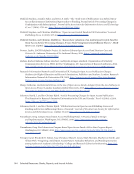4 Survey Results: Executive Summary
Articles in the sciences have received most of the funding. Half of the commenting libraries
specified funding articles in the medical and health sciences fields and 20% specified the life sciences.
Funding for social science and arts and humanities articles were mentioned by 30%.
Hybrid OA Journals
Requests for APCs for hybrid journals are not funded at 27 of the reporting libraries (84%) for a
variety of reasons. Most frequently (53%) institutions consider paying APCs for articles published in
hybrid journals to be “double dipping.” This refers to the institution paying APCs in addition to the full
subscription price of the journals. Institutions that fund OA articles in hybrid journals expect sufficient
evidence that publishers are actually reducing subscription costs as a result of receiving APCs. Comments
revealed that institutions would like the publishers to be more transparent about lowering subscription
fees in proportion to the APC received. The percentage of libraries not funding articles in hybrid journals
is significantly higher than the approximately 50% rates found in previous studies.5
Other reasons for not funding hybrid journals include limited funding and “to incentivize
publishing in, and support for, full OA journals.” However, one institution reported that “as part of a
special promotion to attract more authors from the humanities, we will pay hybrid journal APCs for
authors affiliated with the College of Arts &Humanities.” Institutions that fund APCs in hybrid OA
journals do so because they want “to provide as much support as possible to authors publishing in OA
journals,” though some do so with a reduced per-article cap.
The most significant advantage of funding hybrid APCs is that it greatly expands the author’s
choice of publishing venue, roughly doubling the number of journals in which to publish OA.6 There have
also been hopes that the hybrid model would help journals transition to full OA. Although some journals
have made this transition, we are not aware of evidence showing that this is occurring at a significant
scale. Respondents were primarily concerned with the issue of subscription offsetting, or “double
dipping,” though hybrid OA suffers from other disadvantages such as higher APCs.7 Libraries with a
subscription to a hybrid journal expect a direct offset (a credit against the subscription cost), and libraries
without a subscription expect a global offset, benefiting all subscribers.8 However, these processes lack
transparency, and a study of 24 major publishers found that their “no double-dipping” statements were
not borne out in reality.9 Also, hybrid OA articles sometimes lack a metadata signal showing their access
status, so discovery can still be a problem.
Policies and Procedures
Authors almost always apply to the library for APC funding this stands to reason as the library usually
administers the fund and controls the budget. Nearly all respondents (28 or 85%) indicated that they
pay the invoices for APCs, however more than half of the libraries require or encourage the author(s) or
their departments to pay the invoice before being reimbursed by the library. About one-third directly pay
invoices through credit cards or checks. Only six institutions have deposit accounts and two mentioned
wire transfers.
Requests for funds are evaluated on a variety of additional criteria. More than two-thirds of the
respondents reported denying funding for articles submitted to journals that are not peer-reviewed or
not listed in an OA registry like the Directory of Open Access Repositories. In addition, libraries expect
funded publishers to adhere to an established code of conduct such as is required for membership in the
Open Access Scholarly Publishers Association (OASPA).
Six of 20 respondents (30%) reported that they consider “Beall’s List” (i.e., the formally named
Scholarly Open Access blog subtitled “Potential, possible, or probable predatory scholarly open-access
publishers” at https://scholarlyoa.com/publishers/) when evaluating publications for APC funding. Only
Articles in the sciences have received most of the funding. Half of the commenting libraries
specified funding articles in the medical and health sciences fields and 20% specified the life sciences.
Funding for social science and arts and humanities articles were mentioned by 30%.
Hybrid OA Journals
Requests for APCs for hybrid journals are not funded at 27 of the reporting libraries (84%) for a
variety of reasons. Most frequently (53%) institutions consider paying APCs for articles published in
hybrid journals to be “double dipping.” This refers to the institution paying APCs in addition to the full
subscription price of the journals. Institutions that fund OA articles in hybrid journals expect sufficient
evidence that publishers are actually reducing subscription costs as a result of receiving APCs. Comments
revealed that institutions would like the publishers to be more transparent about lowering subscription
fees in proportion to the APC received. The percentage of libraries not funding articles in hybrid journals
is significantly higher than the approximately 50% rates found in previous studies.5
Other reasons for not funding hybrid journals include limited funding and “to incentivize
publishing in, and support for, full OA journals.” However, one institution reported that “as part of a
special promotion to attract more authors from the humanities, we will pay hybrid journal APCs for
authors affiliated with the College of Arts &Humanities.” Institutions that fund APCs in hybrid OA
journals do so because they want “to provide as much support as possible to authors publishing in OA
journals,” though some do so with a reduced per-article cap.
The most significant advantage of funding hybrid APCs is that it greatly expands the author’s
choice of publishing venue, roughly doubling the number of journals in which to publish OA.6 There have
also been hopes that the hybrid model would help journals transition to full OA. Although some journals
have made this transition, we are not aware of evidence showing that this is occurring at a significant
scale. Respondents were primarily concerned with the issue of subscription offsetting, or “double
dipping,” though hybrid OA suffers from other disadvantages such as higher APCs.7 Libraries with a
subscription to a hybrid journal expect a direct offset (a credit against the subscription cost), and libraries
without a subscription expect a global offset, benefiting all subscribers.8 However, these processes lack
transparency, and a study of 24 major publishers found that their “no double-dipping” statements were
not borne out in reality.9 Also, hybrid OA articles sometimes lack a metadata signal showing their access
status, so discovery can still be a problem.
Policies and Procedures
Authors almost always apply to the library for APC funding this stands to reason as the library usually
administers the fund and controls the budget. Nearly all respondents (28 or 85%) indicated that they
pay the invoices for APCs, however more than half of the libraries require or encourage the author(s) or
their departments to pay the invoice before being reimbursed by the library. About one-third directly pay
invoices through credit cards or checks. Only six institutions have deposit accounts and two mentioned
wire transfers.
Requests for funds are evaluated on a variety of additional criteria. More than two-thirds of the
respondents reported denying funding for articles submitted to journals that are not peer-reviewed or
not listed in an OA registry like the Directory of Open Access Repositories. In addition, libraries expect
funded publishers to adhere to an established code of conduct such as is required for membership in the
Open Access Scholarly Publishers Association (OASPA).
Six of 20 respondents (30%) reported that they consider “Beall’s List” (i.e., the formally named
Scholarly Open Access blog subtitled “Potential, possible, or probable predatory scholarly open-access
publishers” at https://scholarlyoa.com/publishers/) when evaluating publications for APC funding. Only
























































































































































